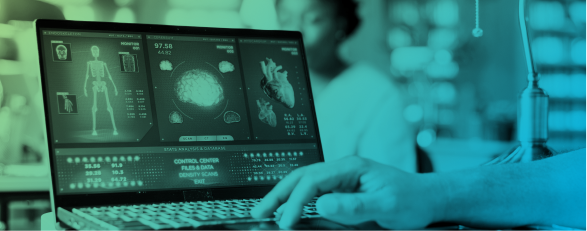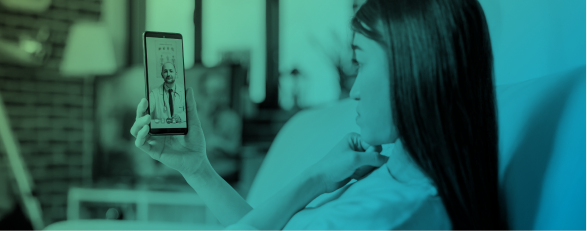Behavioral health care doesn’t end when a patient walks out of the clinic. Progress depends…
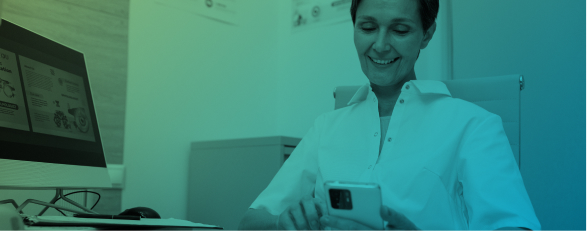
Secure Messaging in Healthcare: Why It Matters & Best Practices
In healthcare, a single message can either change a life or compromise one. With sensitive patient data flying between devices, departments, and providers, secure communication is a critical component and a backbone of trust, compliance, and quality care.
This blog unpacks why secure messaging is the need of the hour for modern healthcare organizations. You’ll learn what’s at stake when privacy protocols fall short, the core features of a HIPAA-compliant messaging system, and the best practices top healthcare organizations use to protect both their patients and their reputations.
Understanding Secure Messaging in Healthcare
Healthcare organizations are required by law to protect their patients’ information. It’s why you never see medical professionals use their personal smartphones to send/receive patient files or lab reports from each other. They instead rely on secure messaging systems that encrypt every outgoing message, ensuring digital safety and meeting healthcare security standards.
Consider a cardiac unit where nurses need to update multiple specialists about a patient’s condition changes. Instead of phone calls or unsecured texts, they send encrypted messages through the hospital’s secure platform. The cardiologist receives the update immediately, reviews the patient’s chart, and responds with adjusted medication orders, all within a protected system that logs every interaction.
Why Ensuring Secure Messaging Is Important in Modern Healthcare
As we’ve already established, standard messaging apps, email, and phone calls create security gaps that expose both patients and healthcare providers to serious risks. Secure messaging is the only way to address these vulnerabilities.
Protecting the Patient Data
Every patient file is a goldmine, containing highly private details such as social security numbers, medical histories, insurance information, personal identifiers, treatment records, etc. This wealth of sensitive data makes healthcare providers prime targets for hackers and cybercriminals because personal data sells for high prices on the dark web.
Secure messaging platforms encrypt messages during transmission and storage. So, even if hackers intercept communications, they cannot read the encrypted content without proper decryption keys. These systems also include automatic data deletion schedules and backup encryption to prevent data loss during system breaches.
Preventing any Unauthorized Access
Healthcare providers can easily have hundreds of staff members who require different levels of information. An unsecured messaging system would normally give all of them the same access rights. With role-based access controls, though, medical staff can be limited to only accessing information that’s meant for them.
For instance, administrative staff can send appointment reminders to patients but cannot view their clinical notes. Since each user receives unique login credentials, the system can keep track of their message activities. This communication trail is highly useful during audits and for preventing former employees from accessing their accounts.
It’s a Requirement for HIPAA Compliance
HIPAA basically sums up the core reason why modern healthcare organizations need to focus on secure messaging. HIPAA sets policies that require providers to protect their patients’ information. If a facility fails to meet those standards, it ends up facing costly fines. Continued violations can even mean sanctions.
Secure messaging platforms come with built-in HIPAA compliance features, including the ability to generate compliance reports and maintain audit trails for regulatory inspections.
Plays a Role in Earning Patient Trust
You cannot expect patients to share their health information unless they trust your healthcare system. This withholding of information (symptoms, medical histories) can lead to misdiagnoses or poor treatment plans. Hence, healthcare organizations that prioritize secure communication create environments where patients openly discuss health concerns.
For instance, a patient with mental health symptoms feels safer messaging their psychiatrist through an encrypted portal than leaving voicemails with reception staff.
Best Practices for Ensuring Secure Messaging in Healthcare
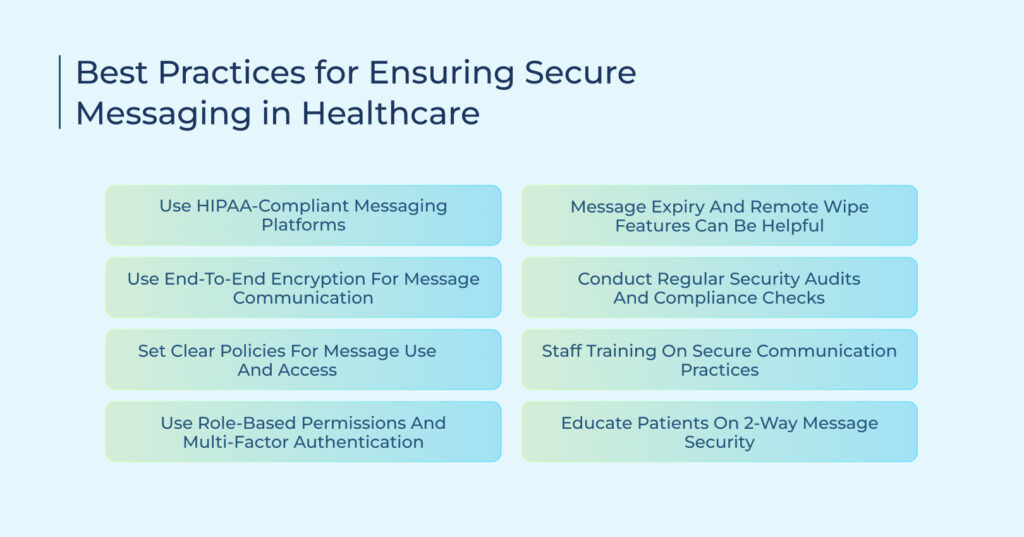
Below are some major practices that healthcare organizations should always prioritize to protect their patients’ sensitive information.
Use HIPAA-Compliant Messaging Platforms
It’s critical that healthcare organizations only use HIPAA-compliant messaging platforms for their workflows. These systems come with pre-built security features that make it easier for providers to enforce (and manage) secure communications at all access levels.
That said, keep in mind that popular or consumer-grade messaging apps like WhatsApp are not meant for healthcare communications. They may provide end-to-end encryption, but are ultimately not designed for a healthcare environment that must meet HIPAA regulations.
Use End-to-End Encryption for Message Communication
End-to-end encryption protocols protect messages from the moment they are sent to the moment they are delivered, preventing any third party from reading them while en route. The same encryption also helps secure messages that are stored on servers. So, even if a hacker manages to access the server, they still need a security token or decryption key to gain access.
Set Clear Policies for Message Use and Access
Healthcare providers must have written policies that clearly lay out which staff members can access secure messaging, what types of information can be shared, and how long messages should be retained.
For instance, define appropriate message content guidelines. Clinical updates, test results, and care coordination discussions belong in secure messaging. Personal conversations, non-work-related topics, and gossip should not appear in these systems.
Establish protocols for emergency communications. Staff should know when to use secure messaging versus phone calls for urgent patient situations. Some platforms include priority messaging features that send immediate notifications for critical communications.
Use Role-Based Permissions and Multi-Factor Authentication
Configure user permissions based on job responsibilities and patient care needs. Nurses in the cardiac unit need access to cardiology communications but not pediatric discussions. Billing staff require access to payment-related messages but not clinical notes.
Multi-factor authentication, on the other hand, adds a security wall by requiring additional verification beyond usernames and passwords. This prevents unauthorized access even if someone steals or guesses a password.
Message Expiry and Remote Wipe Features Can be Helpful
Another way to reduce the risk of data breaches is to have time-limited messages. For instance, a healthcare provider can have messages automatically delete themselves after a month or two. This reduces the amount of sensitive data stored in the system. Messages that don’t require long-term storage can even be set to self-destruct within days.
Secure messaging platforms can also include remote wipe capabilities. So, if an employee loses their phone, the IT staff can easily delete all data from that device from a remote location.
Conduct Regular Security Audits and Compliance Checks
Every security system needs regular audits and reviews to ensure it is working as intended. On that note, healthcare organizations can set quarterly and annual audits to identify (and fix) potential security gaps and vulnerabilities before they become serious issues.
Monitor failed login attempts, unusual access patterns, and messages sent outside normal business hours. These activities may indicate security breaches or policy violations that require immediate attention.
Maintain documentation of all security measures, policy updates, and training activities. This documentation demonstrates compliance efforts during regulatory inspections and helps identify areas for improvement.
Staff Training on Secure Communication Practices
Provide initial training for all staff members who will use secure messaging systems. Training should cover platform features, security best practices, and organizational policies for appropriate usage.
Include training on recognizing phishing attempts and social engineering tactics that target healthcare workers. Staff members should know how to verify sender identities and report suspicious messages.
Have annual training sessions to refresh and update all employees, or when new features are added to the messaging platform.
Educate Patients on 2-Way Message Security
It’s equally important to educate patients on how to engage securely and protect their information. Create simple instructions for them that explain how to log into their patient portals safely, protect their passwords, and recognize messages from official channels.
Patients also need to know that they should always log into their secure messages from personal devices, not public or shared computers.
Provide clear contact information for patients who experience technical difficulties or security concerns with the messaging system. Quick resolution of patient concerns maintains trust and prevents them from using unsecured alternatives.
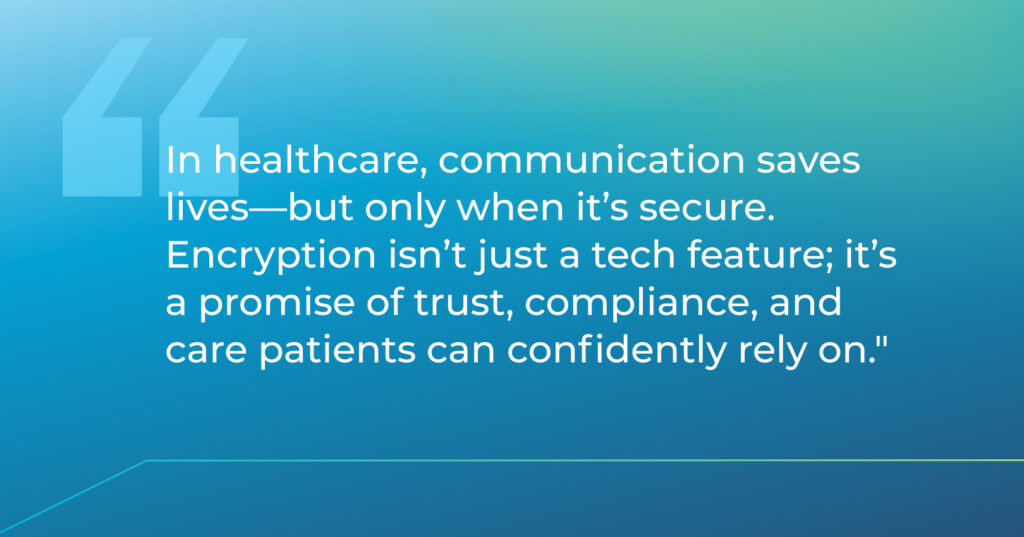
How TeleVox Ensures Secure Text Messaging for Patients in Healthcare
Ever wonder if sending that quick test result update via your phone could jeopardize patient privacy? TeleVox answers that concern with a robust, HIPAA-compliant text messaging platform built to protect patient data without sacrificing ease or speed.
Every message sent through TeleVox is encrypted end-to-end, shielding PHIs during both transmission and storage. Role-based access controls ensure only authorized personnel can view sensitive information, and audit trails provide a full record of every interaction, supporting both compliance and accountability.
But TeleVox doesn’t stop at security. With SMART Agent, our AI-powered virtual concierge, healthcare teams can have two-way conversations via phone, text, or online chat. Patients receive timely updates, appointment reminders, and answers to FAQs, all personalized, persistent, and EHR-integrated.
Imagine automated appointment confirmations, prescription refill prompts, or follow-up instructions delivered securely and instantly. And with centralized, EHR-integrated workflows, staff can manage these communications swiftly, minimizing manual entry and burnout, all backed by the peace of mind that texting stays within regulatory boundaries
Ready to transform patient communication into your strongest asset? Schedule a demo today and discover how TeleVox combines rock-solid security and HIPAA compliance.


